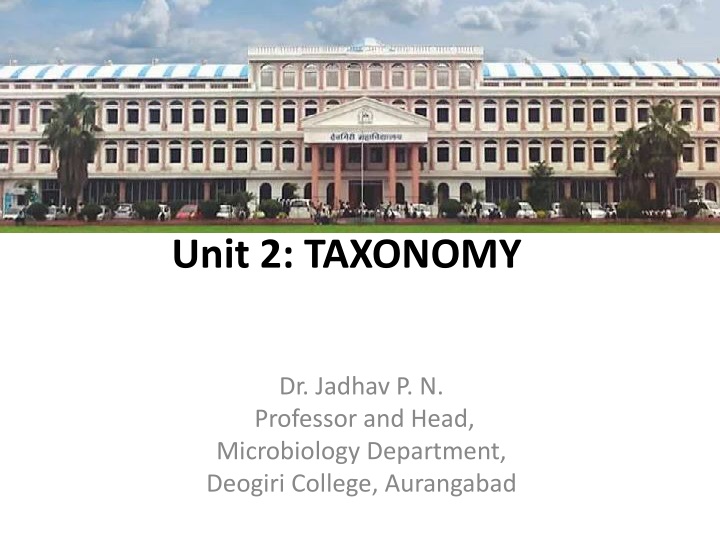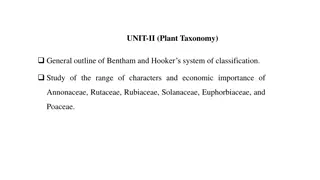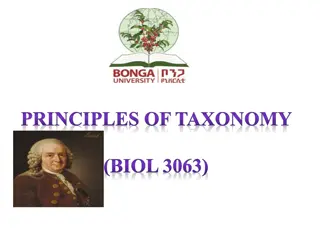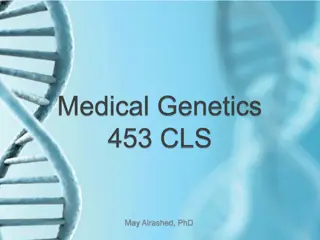Unit 2: TAXONOMY
This content explores the importance of taxonomy in microbiology, including the taxonomic ranks used in bacterial classification, the binomial system of nomenclature, and different classification systems like natural, phenetic, and phylogenetic. Understanding these concepts is essential for accurate identification and organization of organisms in the field of microbiology.
Download Presentation

Please find below an Image/Link to download the presentation.
The content on the website is provided AS IS for your information and personal use only. It may not be sold, licensed, or shared on other websites without obtaining consent from the author.If you encounter any issues during the download, it is possible that the publisher has removed the file from their server.
You are allowed to download the files provided on this website for personal or commercial use, subject to the condition that they are used lawfully. All files are the property of their respective owners.
The content on the website is provided AS IS for your information and personal use only. It may not be sold, licensed, or shared on other websites without obtaining consent from the author.
E N D
Presentation Transcript
B. Sc. First Year Semester I Paper I Fundamentals of Microbiology Unit 2: TAXONOMY Dr. Jadhav P. N. Professor and Head, Microbiology Department, Deogiri College, Aurangabad
B. Sc. First Year Semester I Paper I Fundamentals of Microbiology Unit 2: TAXONOMY Dr. Jadhav P. N. Associate Professor and Head, Microbiology Department, Deogiri College, Aurangabad
Importance of Taxonomy Allows scientists to organize huge amounts of knowledge. Allows scientists to make predictions and frame hypotheses about organisms. Essential fro accurate identification of organisms.
Taxonomic Ranks In bacterial taxonomy, a bacterium is placed within a small but homogenous group in a rank or level. Groups of this rank or level unite creating a group of higher rank or level. In bacterial taxonomy, the most commonly used ranks or levels in their ascending order are: species, genera, families, orders, classes, phyla, and domain. Table: Taxonomic ranks or levels in ascending order
Binomial system of nomenclature devised by Carl von Linn (Carolus Linnaeus) each organism has two names genus name italicized and capitalized (e.g., Escherichia ) species epithet italicized but not capitalized (e.g., coli) can be abbreviated after first use (e.g., E. coli)
Classification system natural classification arranges organisms into groups whose members share many characteristics most desirable system because reflects biological nature of organisms two methods for construction phenetically - grouped together based on overall similarity phylogenetically - grouped based on probable evolutionary relationships
Phenetic classification groups organisms together based on mutual similarity of phenotypes can reveal evolutionary relationships, but not dependent on phylogenetic analysis i.e., doesn t weight characters best systems compare as many attributes as possible
Strains population of organisms that is distinguishable from others within a taxon descended from a single organism or pure culture isolate vary from each other in many ways biovars - differ biochemically and physiologically morphovars -differ morphologically serovars - differ in antigenic properties
Type of strain usually one of first strains of a species studied often most fully characterized not necessarily most representative member of species
Phylogenetic classification also called phyletic classification systems phylogeny evolutionary development of a species usually based on direct comparison of genetic material and gene products
Numerical Taxonomy used to create phenetic classification systems multistep process code information about properties of organisms e.g., 1 = has trait; 0 = doesn t have trait use computer to compare organisms on 50 characters determine association coefficient construct similarity matrix identify phenons and construct dendograms
Association Coefficients Table: Association Coefficients for two organisms Simple matching coefficient proportion of characters that match regardless whether attribute is present or absent Ssm = a+d /(a+b+c+d) Jaccard coefficient ignores characters that both lack Sj = a /(a+b+c)
Major characteristics used in taxonomy Two major types classical characteristics molecular characteristics
Classical characteristics The characteristics are assessed and the data are used to group bacteria up to the taxonomic ladder from species to domain. Classical characteristics are quite useful in routine identification of bacteria and also provide clues for phylogenic relationships amongst them as well as with other organisms. morphological physiological and metabolic ecological genetic analysis
Table: Some taxonomically useful morphological characteristics and their variations























